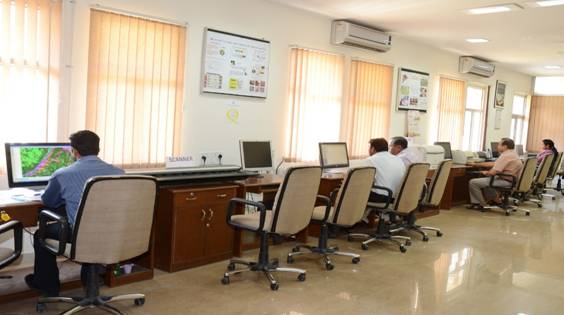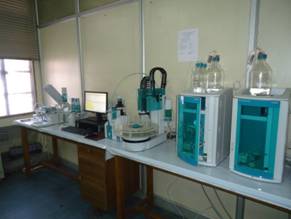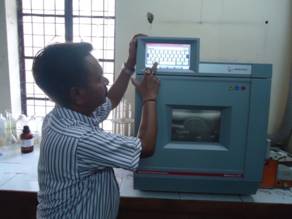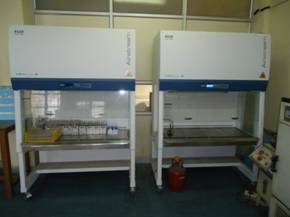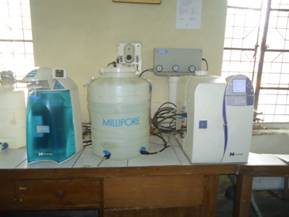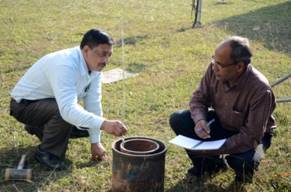LABORATOries
The Institute has well-equipped laboratories with state-of-art monitoring and analytical instruments powered by a top-of-the-line team of scientists, supporting scientific and technical staff. Laboratories provide a superbly-equipped, dynamic and broad-based research environment. Keeping this in view, the following eight laboratories have been established at the Institute.
The Nuclear Hydrology laboratory is equipped with the instruments for measurement of stable as well as radio isotopes in water and sediments. The instruments are being used for field investigations and laboratory analysis for the study of soil moisture movement and estimation of recharge to groundwater, surface water and groundwater interaction, lakes studies, groundwater dating and identification of recharge sources and zones of deeper aquifers and springs.
Nuclear Hydrology Laboratory has three sub-sections, i.e., Groundwater Dating Laboratory, (ii) Stable Isotope Laboratory, and (iii) Sediment dating laboratory. Important instruments available in the Stable Isotope Laboratory are: Dual Inlet Isotope Ratio Mass Spectrometer (DIIRMS), Continuous Flow Stable Isotope Ratio Mass Spectrometer (CFIRMS) with Elemental Analyser (EA) for measuring δD, δ13C, δ15N, δ18O, δ34S and δ37Cl in water and solids, Isotopic Water Analyzer (Liquid+Vapor) from LGR (Los Gatos Research) for measuring δ2H, δ17O, δ18O. Groundwater Dating Laboratory is equipped with Tritium Enrichment Units (2 No.), CO2 sample preparation lines, CO2 absorption line, Ultra Low Level Liquid Scintillation Spectrometer (Quantulus), Soil Moisture Extraction Units and Liquid Nitrogen Plant etc. The facilities are used for tritium and carbon dating of groundwater. Sediment Dating laboratory has Multichannel Gamma Ray Spectrometer, Geolog Rate Meter, Neutron Moisture and Density Probe, Ultrasonic Depth Indicator. Two sets of radon detectors are also available in the laboratory.
The laboratory is also equipped with Ion Chromatograph System-5000 of Dionex for analysis of ions, heavy metals, pesticides, carbohydrates etc. This instrument is useful in assessment of water quality and being used for various studies in the division.
Facilities of the laboratory were extended to Regional Centres and other divisions of the Institute for their technical studies. Facilities of the laboratory were also extended to various other departments/agencies like; PRL, Ahmedabad; NGRI, Hyderabad; JNU, New Delhi; NCAOR, Goa, IIT, Roorkee, IIT, Kanpur; IIT, Guwahati; Delhi University, Annamalai University; Central Ground Water Board etc.
During the year 2015-16, more than 8,000 water samples (precipitation, rivers, springs, air moisture and groundwater) were analyzed for δ2H and δ18O. Around 250 water samples were analyzed for environmental tritium and around 1600 water samples were analyzed for water chemistry on Ion Chromatograph.
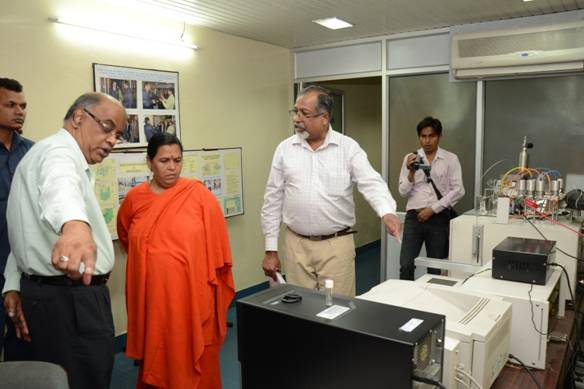 Hon’ble Union Minister, Water Resources, River Development and Ganga Rejuvination visiting the Nuclear Hydrology Laboratory on October 26, 2015 |
|
Remote sensing and GIS Laboratory carries out studies and research on various aspects of hydrology and water resources using remote sensing and GIS techniques. Software available in the Laboratory include ArcGIS, ERDAS Imagine, ILWIS, ENVI, and R2V (Raster to Vector Conversion software). The laboratory also has A0 Colortrac Smart-F Image Scanner, Laser Colour Printer, A0 size Cannon Colour plotter etc. The laboratory also maintains large number of Survey of India topographic maps and satellite remotely sensed data which are being used in hydrological studies at the Institute.
The Water Quality Laboratory is well-equipped with state-of-art equipment to identify and quantify physical, chemical and bacteriological parameters in various water bodies like rivers, lakes, reservoirs, wells, aquifers, canals etc. The laboratory has facilities and capabilities to determine major and minor ions, trace elements, pesticides, PAHs and bacteriological parameters.
The major equipment available in the laboratory include Ion Chromatograph with Auto Titrator and Voltametry, Gas Chromatograph, Mercury Analyzer, Flame Photometer, Portable Environmental Laboratory, Biosafety Cabinet, Research Microscope, Microwave Digester, Ultrapure Water Purification System, Deep Freezer, Autoclave etc.
|
|
|
|
The Soil and Water Laboratory has modern equipment for laboratory and field measurement of the soil physical and hydrologic properties. The major capabilities include determination of soil particle size distribution for textural analysis, permeability, porosity, infiltration, soil density, soil moisture at different suction for determination of the soil moisture characteristics curves, saturated hydraulic conductivity, sorptivity and matrix flux potential of soils, in-situ soil moisture, soil salinity and pH, leaf area index, foliage and other canopy measurements in command area etc. using advanced instrumentation and techniques. Major instruments available in the laboratory include Pressure Plate Apparatus, Soil Particle Size Analyzer, Guelph In-situ Permeameter, TDR Soil Moisture Probe, ICW Lab Permeameter, Multi Volume Pycnometer, Infrared Soil Moisture Balance, Digital pH & Conductivity meter, Constant Head Permeameter, Falling Head Permeameter, Electromagnetic Sieve Shaker, Tensiometers, Double Ring Infiltrometers, and Plant Canopy Analyser. In addition to routine laboratory based analysis of soil samples, the laboratory is providing services in the field for collecting disturbed/undisturbed samples, conducting in-situ measurement of various soil parameters and for field surveys related to the studies taken up by various divisions including the sponsored / consultancy projects. During the year 2015-16, various field and laboratory analysis were carried out mainly for Kulsi Pilot Basin (Assam/ Meghalaya), North West Himalayas, Yamuna-Hindon Inter-basin (Uttar Pradesh), Akolner village, (Ahmednagar, Maharashtra), Peya Jal Suraksha Project (Agra/Mathura), Mewat (Haryana). About 254 soil samples in total were analyzed in the lab during the year 2015-16 for determination of soil texture, soil moisture characteristic curve, bulk density, porosity, soil moisture, soil EC and pH etc. besides conducting experiments for measurement of various soil properties in the field.
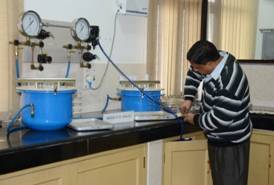 Determination of soil moisture characteristic curve using pressure plate apparatus |
|
National Institute of Hydrology has been carrying out hydrological studies since 1999 on Gangotri Glacier, which is one of the biggest glaciers of Himalayas. In the Snow and Glacier laboratory analysis and modelling of Snow and Glacier melt runoff, based on the observations taken at the Gangotri site of the meteorological observatory with AWS established at Gangotri Glacier at an altitude of 3600 m are carried out. A stream flow discharge site is also being maintained at that location. A conceptual model for simulating snow and glacier melt runoff has been developed at the institute and is being applied for snow and glacier modelling at this lab. Since most of these facilities are at harsh location and inaccessible sites the details of studies are exhibated for the visitors. For local common people a weather display unit is installed over the main building. It displays the instantaneous temperature and relative humidity. The weather parameters observed on previous day are also displayed. The control unit and operation facility is being maintained in the laboratory.
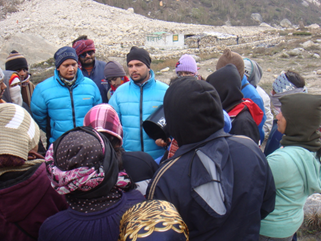 Visitors being briefed about the meteorological conditions around Gangotri Glacier at the observatory near Gangori Glacier |
The Hydrological Instrumentation Laboratory is equipped with conventional as well as modern equipments for various hydrologic measurements. Important instruments available in the laboratory include: Automatic Weather Station, Automatic Rain Gauges (Weighing type, Tipping Bucket type), Self Recording Rain Gauges (Siphon type), Automatic Snow Gauges (IMD type, Anti-freeze type and Weighing type), Digital Evaporation Recorder, Digital Wind Speed & Direction Recorder, Hand-held Anemometer, Non-Recording Rain Gauges, Evaporation Pan, Digital Surface Water Level Recorders, Digital Ground Water Level Recorders, Water Level Indicators (Sounders), Propeller Water Current Meter, Mini Current Meter, Ocean Flow Meter, Suspended Sediments Sampler, Depth Water Sampler, Weirs, Terrameter, EM Conductivity Meter, Digital Soil Moisture Meter, Digital Soil Moisture Recorder, Tensiometers, Guelph Permeameter for Hydraulic Conductivity, Soil Water Samplers etc.
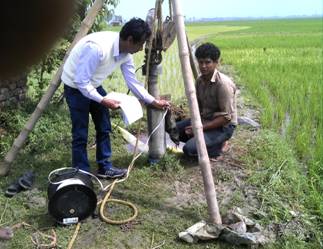 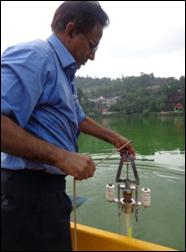 Hydrological Instrumentation Laboratory Hydrological Instrumentation Laboratory |
TThe Centre of Excellence for Advanced Groundwater Research (CEAGR) is established under the Ground Water Hydrology Division of National Institute of Hydrology, Roorkee. This centre comprises of two units: (i) Numerical Groundwater Modeling Unit, and (ii) Indo-German Competence Centre for Riverbank Filtration, to cater the R & D services in groundwater sector. The centre has the state-of-art tools on hardware and software for dealing with computationally challenged problems.
The centre has a capacity for working of fourteen researchers besides a discussion/meeting area and a display section. The centre is equipped with various kinds of soft-computing tools related to groundwater like: groundwater quantity and quality modeling using MODFLOW/MODFLEX/FEEFLOW, integrated catchment modelling using MikeSHE, unsaturated zone modelling using WHI UnSat Suite Plus, spatial analysis using ArcGIS/TNT Mips, statistical analysis using Systat, geological characterizing using HydroGeoAnalyst, 3D contouring using Surfer and water quality characterization using AquaChem. Besides this, the centre also has the internet and hardware facility of fourteen terminals of PCs/Workstations, LCD Screen, LCD Projector, A0 Size Scanner and Plotter,Coloured Photocopier, A4 size scanner and printers, etc.
The Centre was inaugurated by Sushri Uma Bharati Ji, Hon’ble Union Minister for Water Resources, River Development and Ganga Rejuvenation on 26th October, 2016. Scientists, scientific staff, project staff, resource person and PG students pursuing their dissertation work here on the above-mentioned model tools.
. |
